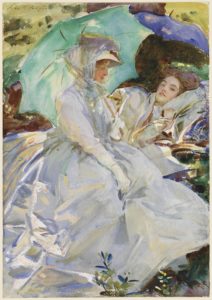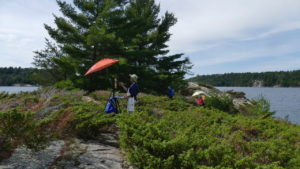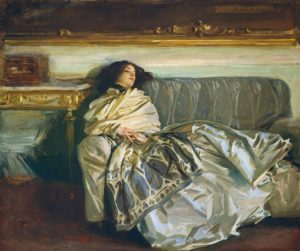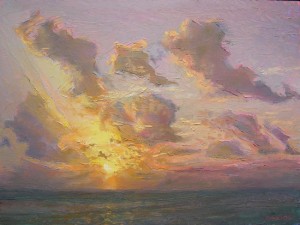Dear Artist,
A subscriber wrote, “I have a bad habit of overworking a painting. I need to turn it to the wall and walk away…start something else…but I do look for ways to improve my work and make a mess…am I alone there? Any suggestions as to what to do?”
I’ve noticed that overworking is often just an overzealous, knee-jerk response to perfectionism, pressure, guilt and self-doubt. Let me explain:
Perfectionism: “Some people think perfection can be achieved by simply continuing,” said my Dad. Rather, excellence is grasped by cultivating hard-won skills over time and knowing what your goals are. While exploration is key to development, he would often recommend a simple ploy of knowing how you want to end up and stopping there. For this exercise, can you summon a mental picture of your finished work? Knowing when to stop is half of mastery.
Pressure: While casual sketches and long, uninterrupted, deadline-free periods in the studio produce fresh and evolving work, commissions can inspire a kind of imaginary, inner critic who watches for errors and leaks skepticism about any ability to satisfy expectations. Pressure can tack on destinationless noodling, second-guessing, laboured passages and turgidity. In this case, overworking is another word for over-compensating. The secret is to understand and accept that the mystery, incompleteness and the unreachable mountaintop of your creative striving are what give your work its ineffable magic.
Guilt: If your fresh sketches are feeling a bit too easy, you may be tempted to indulge in the impulse to go back in to try to add some struggle. “Guilt is that part of human nature that has us think we need to give or do something penitent to be more worthwhile within ourselves,” said my Dad. “Unnatural sacrifice and latent guilt are the wrong reasons to do anything.” Instead, hide your labour — what John Singer Sargent called his “horny hand of toil” — inside the élan of well-executed work. “Start with a whisk,” wrote Sargent, “and end with a broom.”

Simplon Pass (Reading), 1911
Translucent and opaque watercolor, with wax resist, over graphite on paper
51 x 35.7 cm
by John Singer Sargent
Self-doubt: Any successful outcome most often requires a plan. A lack of leadership in any organization — be it a family, a planet or the self — diminishes confidence, producing aimlessness and difficulty with decision-making. This leaves a vacuum for the impulses of our lizard-brains to take over. In art, our lizard brains want to keep pushing paint around until our strokes are destroyed — you only need to inspect the work of toddlers running out of fresh paper to know what I’m talking about — most of that stuff is at genius level after five or six strokes and totally indistinguishable from all others after 20. Self-doubt, like other learned habits, must be vigilantly deadheaded — replaced gradually with personally earned achievements, skill and productive thinking. “Not learning by doing,” wrote Toba Beta, “but learning by risking.”
Sincerely,
Sara
PS: “To be a painter, you need to know how to paint, and when to stop.” (Pablo Picasso)
Esoterica: In my experience, it is better to be 10 percent underworked than 1 percent overworked. Learning how to stop takes practice. Begin by stopping way too early. Here’s an idea: Build up a new set of paintings, in various states of “underworked.” Lay them around your studio and study them over the course of a few weeks. You’ll find your eye growing accustomed to your new, fresh strokes. Release your attachment to the old standards of what you thought was “finished.” Make a gut decision about the exact location of your new sweet spot. Now, go back to an old painting you once felt was a success. Can you now see signs of overworking? “It makes me feel guilty that anybody should have such a good time doing what they are supposed to do.” (Charles Eames)
Have you considered a Premium Artist Listing? With each letter, an artist is featured at the bottom of this page. The Premium Artist Listings are a means of connecting artist subscribers through their work. Proceeds from each listing contribute to the production of The Painter’s Keys.
“A painting works only on the edge of not working. Then what is ungraspable comes near.” (Kazuaki Tanahashi)
Featured Workshop
 The Killarney are of Ontario is in what is called the ‘near north’. The landscape is wild and rugged. Giant granite cliffs plunging deep into the glacial lakes. There are no roads leading to our painting locations. We travel by a large, sturdy pontoon boat. This is a self-catered retreat. You bring your own provisions and cook your own meals in our fully equip cabins at a northern camp. Our instructor, Keith Thirgood, has been teaching artists his own unique approach to painting for over 12 years. Learn how to find order in the chaos, control your colours and create paintings that work. Learn modern colour theory, values, shapes and lines, what makes for a good painting. This retreat is suitable for beginners wanting to learn to paint in a fun, outdoor location, as well as more experienced studio artists who want to try plein air, plus artists who are looking to loosen up and paint in a more post-impressionist style. To find out more and register, please visit www.wilsonstreetstudios.
The Killarney are of Ontario is in what is called the ‘near north’. The landscape is wild and rugged. Giant granite cliffs plunging deep into the glacial lakes. There are no roads leading to our painting locations. We travel by a large, sturdy pontoon boat. This is a self-catered retreat. You bring your own provisions and cook your own meals in our fully equip cabins at a northern camp. Our instructor, Keith Thirgood, has been teaching artists his own unique approach to painting for over 12 years. Learn how to find order in the chaos, control your colours and create paintings that work. Learn modern colour theory, values, shapes and lines, what makes for a good painting. This retreat is suitable for beginners wanting to learn to paint in a fun, outdoor location, as well as more experienced studio artists who want to try plein air, plus artists who are looking to loosen up and paint in a more post-impressionist style. To find out more and register, please visit www.wilsonstreetstudios.
Featured Artist
Capturing the beauty of nature and expressing those impressions in oil paint is a joy. Every hour of the day presents new possibilities and keeps even the same landscape location, same composition, an ongoing and beckoning challenge. For this reason, I love painting series: it is exploration made visual.








18 Comments
Wonderful essay, and love the JSSargent paintings to illustrate. Thanks ever so much. Having the idea/intention for the painting Is something I’m working on. Sometimes I think about not what I want to say, but what needs to be conveyed. Take the intention off my shoulders and let it reveal itself.
Very good and eye opening explanation for my mind and heart, where I can feel satisfied with my painting. Thanks a lot.
Thank you, Sara. I find that “overworking” can happen in just a few minutes before you realize what is happening. I have always tended to work very quickly and “think” that I need to spend a certain amount of time on a painting. I am finally beginning to realize that when I begin to mindlessly dab, it’s actually time to STOP. Also, when I reach a point that I don’t really know what to do next, STOP. I am learning to set the paintings aside where I can see them without “looking” at them … such as on the mantle in the livingroom … not in my studio. They may set there for days and one day a little voice tells me just what to do. Usually my paintings are 95% finished but that final 5% must be just the right thing … may only be a brush stroke. It has been a slow path to learning this important lesson. I’m printing your letter to put in my studio to help remind me.
I very much appreciate this post. It’s a beautiful essay and relevant content for my current work. I have this problem of overworking a painting, and this article speaks to me, thank you! I love this idea that — “it is better to be 10 percent underworked than 1 percent overworked.” A great compass to decide when to finish the painting, and not being too hard on myself to meet perfection. Thank You.
I’ve always loved Sargent’s comment “Start with a whisk and finish with a broom”. I think I know what he means – looseness and bravura brushstrokes are not sloppiness but a learned and deliberate skill. I see it best in the paintings of Richard Schmid but not so much in Sargent.
The great parts in a Sergeant are only seen close up in front of the piece. He has a painting of a small brook and all the stuff on the bottom that is one of my favorite abstract paintings. From ten feet, it’s a photo.
Have you seen his watercolours? They are an exercise in stopping before it’s too late— bravura—and an example for any of us inclined to just add that one more stroke!
I always thought it was ‘Start with a whisky and finish with a beer!’ So that’s where I’ve been going wrong all these years! Doh!
I’ve told dozens of students to stop before you’re “done.”
This is so true, Sara!! Two of the best exercises your dad had us do in the Hollyhock workshop years back were the 37 minute exercise, and the 37 stroke exercise. We were forced to focus on the most important things first: nailing the composition and values. In my studio I’ve found it best to work in the way Virginia Urani posted — get to a place where I don’t know what to do next, then stop painting, and work on something different for a few days, then return with fresh eyes after a few days or longer.
I love the 37 minute/stroke challenge! Fun, informative, and I’ve actually painted some pieces I’m satisfied with.
When one works an abstract painting, you never imagine the final outcome ..each stroke is like a swimmer heading for the candy house, you desire in the end a treat, a surprise. Most of the time the first attempt is not acceptable so it is not so much over-working but digging deeper with hopes of finding gold. Some may call this layering and say it now has depth but is not finish till it’s finish, and one is satisfied. Few of the people that view the work will understand what you’ve done but might feel the struggle it took.
Thank you for this reminder, Sara! I agree with all the subsequent comments, and have “ruined” more than one painting with as little as one last stroke that I thought it needed. Now when I get to that “tweeking” stage , I turn my art upside down and/or sideways and leave it on the mantle for however long it needs to be there to remove me from the urge to “fix it”, or find the solution to do so without ruining it.
I’m happy to see this discussion since I wonder what overworking actually is. My criteria for how long I spend on a painting is to try to determine if I’ve made my intentions for the painting clear. I start from very loose small doodles and review these for ideas that I think can be developed. I plan my paintings ahead of time since they are a mix of figurative and abstract elements. I kind of know what I want these elements to be but I leave room for a certain amount of change. Then I work til the painting says its finished. Sometimes it involves reworking areas 7 or more times til I feel the color and tension between the forms is right. Some paintings take as long as 7 months. My method of working is tight and maybe overworked, but for me the painting has to become what I imagined. Some African artists felt that the more an object is touched, the more power it emanates.
Brilliant essay and I relate to all of it, particularly the feeling that I have to feel I had to struggle in order to produce good work. I’m printing this off and pasting it in the studio! In a prominent place!
Thank you
I have learned from watching students at work, attempting to support them as they tremble for fear of ruining their work, and from trying to shake the tyrannical words of too many of my teachers ,” Don’t OVERWORK it!”.
Those words felt like a sword of Damocles that imprisoned and paralyzed my decision making as a young artist.
Now I tell my students, “Go ahead! Over work it. Go right off the edge. Then you will see if you have discovered something, good or not. Otherwise, you’ll never learn what overworking is for you. It comes with experience, with each decision and each new painting you make. You are the one to decide what is too far, and you will learn that by risking.”
And I will always admire Sargent for his gift of leaving mysterious and deliciously un-tidy areas in his painting. I have a love/hate relationship with the guy. How does he do that???
yes!! so good.
I feel if you listen to your eye and not your brain, you can’t go wrong. Your eye , if you put it dead center of painting, will pull you to what isn’t working in painting. When it stops pulling you, and rests easy, you are done. Your brain will keep saying you are not, because it’s full of voices. Yours and everyone else whe ever commented on other things you painted.